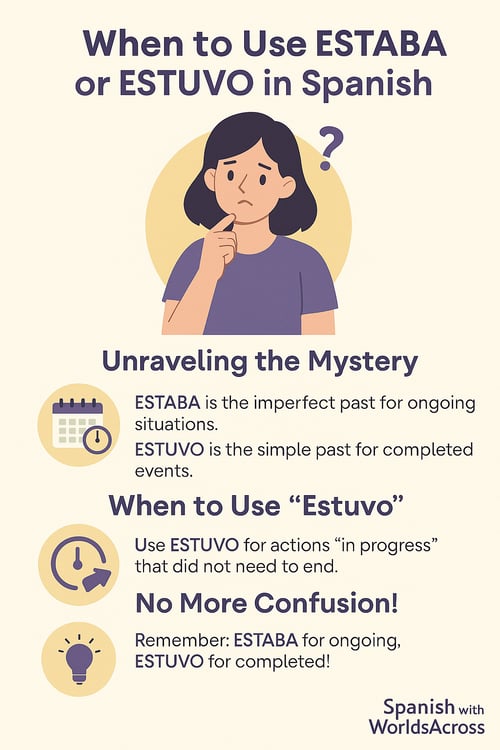When to Use Estaba or Estuvo it in Spanish? The guide you need
Hello, Spanish lover! Today, I want to share an anecdote from a few months ago. I met with Karen, a Canadian friend and Spanish learner. During one of our chats, she was excited because she had gone to a concert by her favorite band.
However, she suddenly fell silent, and her face showed confusion. When I asked what was wrong, she confessed that she had a moment of doubt about whether to use "estaba" or "estuvo" to say the concert was great.
After explaining the difference between "estaba" and "estuvo", she felt much more confident. Can you relate to Karen? Don't worry! In this article, I'll teach you the differences between "estaba" and "estuvo" so you'll know when to use each and say goodbye to any confusion.
Are you ready? Let's go!
Unraveling the Mystery: Preterite vs. Imperfect
Don't worry, the terms may sound complicated, but it's easier than you think. Let's start by clarifying that "estaba" is the imperfect past tense, and "estuvo" is the simple past tense. Here's a simple explanation of both:
"Estaba" (imperfect past) is used to talk about continuous or ongoing situations. Think of it as something that was repeated in the past and didn't necessarily have an end. On the other hand, "estuvo" (simple past) is used to talk about situations that did have an end or occurred at a specific moment.
Also, it's important to remember that in Spanish, context can change the meaning of a sentence. For example, saying "Estaba lloviendo" implies that the rain was a continuous situation, while "Estuvo lloviendo" suggests there was a specific period when it rained. This detail can make a big difference in how we communicate.
Extra Tip: If the terms confuse you, don't worry! You can refer to the imperfect past as "imperfect" and the simple past as "preterite." It's a valid way to simplify them!
When to Use "Estaba"
Use "estaba" when you want to talk about something that happened over a period, something that was "in progress" and didn't necessarily have to end. This word is often used when telling stories, whether real or fictional.
Examples:
- Yo estaba viendo TV en mi cuarto.
Here, we say "estaba" because the action of watching TV lasted for a while, without a specific ending at that moment. - La noche estaba muy fría.
Here, we use "estaba" to describe that the coldness of the night was a continuous condition, without a clear limit. - Estaba estudiando para mis exámenes finales.
This example shows that studying was a process that took time and effort, without immediate conclusion.
When to Use "Estuvo"
In this "estaba vs. estuvo" competition, "estuvo" is likely easier to understand. Use "estuvo" when you want to talk about something specific that began and ended at a certain moment. In other words, think of those things that happened and were completed.
Examples:
- ¡Mi día estuvo fantástico!
Here, we say "estuvo" because we refer to a past day, an event that started and ended. - La clase estuvo muy divertida.
Here, we use "estuvo" to talk about the class as an event that started and ended, emphasizing how fun it was. - La película estuvo increíble.
This example highlights that the movie was a complete experience, from beginning to end, and leaves us with a positive impression.
Reminder: Knowing when to use "estuvo" is simple! Just remember to use it for those concrete situations that had a beginning and an end. You can do it!

Practicing with Fun Exercises
Well done! You’ve mastered the theory—ready for practice? Here are some exercises on the imperfect vs. preterite to boost your learning. Don’t rush! Take your time to analyze and answer correctly. Answers will be at the end for you to check. Let’s go!
- ¡Mi fiesta de cumpleaños _________ genial!
- ¡El espectáculo de fuegos artificiales _________ increíble!
- Yo ________ haciendo mi tarea, cuando llegó mi familia de visita.
- La obra de teatro _________ muy interesante.
- Cuando llegué a casa, mi madre __________ viendo su serie favorita.
- Ayer ________ lloviendo tanto, que no pude salir de casa.
Answers:
- Estuvo.
- Estuvo.
- Estaba.
- Estuvo.
- Estaba.
- Estaba.
No More Confusion: Mastering the Difference between "Estaba vs. Estuvo"
Great job! If you’ve made it this far, we can say you know and master the difference between "estaba" and "estuvo." Remember: use "estaba" to talk about ongoing situations and "estuvo" for those that are specific and completed. At first, it may seem difficult, but with a little practice and patience, this imperfect vs. preterite battle will be a piece of cake. So don’t worry if you make mistakes now and then! Every mistake is an opportunity to keep growing and improving.
See you next time!



